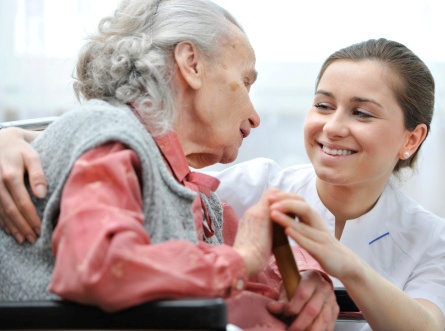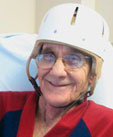Infection Prevention, Environmental Services Team Up to Expand ‘Cleaning Grid'
Lather well.
Sing Happy Birthday twice.
Don’t forget to wash beneath nails and between fingers.
 After years of health care workers maintaining a hyper-focus on clean hands, the pendulum is starting to swing in another direction: Renewed national concern around environmental cleanliness.
After years of health care workers maintaining a hyper-focus on clean hands, the pendulum is starting to swing in another direction: Renewed national concern around environmental cleanliness.
“Certainly, hand hygiene will always be critical, but now we’re also paying much more attention to the hospital environment, especially when it comes to cleaning shared equipment like stethoscopes, walkers, blood pressure cuffs, and IV poles,” said Ann Marie Pettis, director of Infection Prevention at URMC’s Strong Memorial and Highland hospitals. “We’re currently tracking 40 surfaces in patient rooms, including the underside of bedside trays, light switches, and call bells to make they’ve been cleaned daily and at discharge. It’s a pretty exhaustive list.”
The rekindled emphasis on environmental cleaning is in large part due to the national spotlight on C. difficile, a bacterium that vexes hospitals and long-term care facilities. The microbe’s protective shell makes it particularly hard to kill; once ingested, it can cause severe diarrhea, colon inflammation, sepsis, and even death (most commonly in older patients undergoing a course of antibiotics, though even healthy, younger individuals can be affected).
As a nation, the superbug has really challenged traditional thinking about what it means to create a safe and clean hospital, Pettis said. “But it’s worthwhile. If we can make progress eradicating this hardy organism, we’ll be better off in preventing many other health care-associated infections.”
Marrying Infection Prevention, Environmental Services
As part of the national effort to fight C. diff, four Rochester hospitals (Strong Memorial, Highland, Unity, and Rochester General), with support from Excellus, have pooled brain-power, forging the new Rochester Patient Safety Collaborative. Led by URMC infectious disease expert Ghinwa Dumyati, M.D., the group aims to standardize cleaning methods (among other practices) across institutions.
“We’re still fine-tuning our approach, but it’s aggressive,” said Larry Weidner, who directs Environmental Services at URMC. "We’re working with departments to sketch out a comprehensive cleaning grid that, for the first time, carefully spells out shared items that enter or leave rooms, along with every surface that needs disinfecting.”
Understandably, a lot of the heavy lifting falls to Strong’s busy environmental services team, under Weidner’s charge. Each new member already spends five days in classroom training, learning cleaning protocols, the ins-and-outs of materials safety, and the importance of creating an environment that’s as germ-free as possible.
“We work hand-in-glove with Infection Prevention for a lot of this training,” Weidner said. “We’ve also begun using black light germ-detection technology, showing new staff that visual inspection alone is unreliable. Surfaces that appear tidy can actually harbor whole colonies of bacteria that would be devastating to our patients. It’s a real eye-opener.”
On top of this intensive education, veteran employees supervise new hires out in the field for up to two weeks, offering additional hands-on training. And the learning doesn’t end there; as part of the four-hospital C. diff collaborative, random surfaces are swabbed each week, testing for leftover ATP--an organic compound found in living cells and microbes, indicating areas that cleaning staff might have missed. When the swabs are placed within a luminator, any organic matter they’ve accumulated emits a glow similar to that of fireflies.
“We can precisely measure this glow in light units. The brighter it is, the more organic matter on the surface,” Pettis said. “It’s not meant to be punitive, so much as instructive. We ask staff to clean the surface again, then we re-swab to show them the difference. We want to really emphasize the power of elbow grease.”
Trialing New Technologies
Of course, while education is vital, it’s only one piece of the puzzle. Having the right tools in place is just as important.
Strong Memorial and Highland were the first hospitals in the region to switch to powerful bleach-based detergents for routine room cleaning, according to Pettis and Weidner. For a couple of years now, they’ve also been using a UV light machine to “fry” germs in rooms previously occupied by patients known to have C. diff. Though rigorous clinical trials have yet to validate UV light as an effective means of preventing C. diff. infections, Rochester’s C. diff collaborative plans to study just that; in fact, in March, each participating hospital received a donation of two second-generation UV machines from the John and Jayne Summers Foundation. The data will be among the first in the nation to shed light--literally--on whether or not UV machines deserve a permanent place in the cleaning arsenal
Still more technologies and processes soon will take place behind the scenes, such as a pilot project, likely launching in late spring, to retrofit a cart-wash system for cleaning hospital commodes.
“These ‘rolling toilets’ are currently disassembled and scrubbed by hand,”Weidner said. “But we anticipate that this kind of enhanced cart-wash system, housed right in our hospital’s Sterile Processing Department, could propel sanitization to a whole new level.”
While it represents change for one type of equipment, Weidner says it’s the start of a new way of re-engineering environmental cleaning.
“It’s an exciting time to be in this field,” he said. “We’re really pushing the envelope, striving to stay ahead.”
Scott Hancock | 10/1/2012



